Discover natural allergy relief with nettle tea, a potent herbal remedy rich in antihistamines and anti-inflammatory compounds. To brew, steep 1-2 teaspoons of dried nettle leaves in hot water for 10-15 minutes. Drink 1-3 cups daily, starting 2-3 weeks before allergy season for best results. Harvest nettles safely using gloves, or purchase dried leaves. Enhance flavor with honey or lemon, and store properly to maintain freshness. Regular consumption may offer long-term health benefits beyond allergy relief. You'll find that brewing your own nettle tea is a simple yet effective way to combat seasonal allergies naturally. Explore further to reveal the full potential of this powerful herb.
Understanding Nettle's Allergy-Fighting Properties
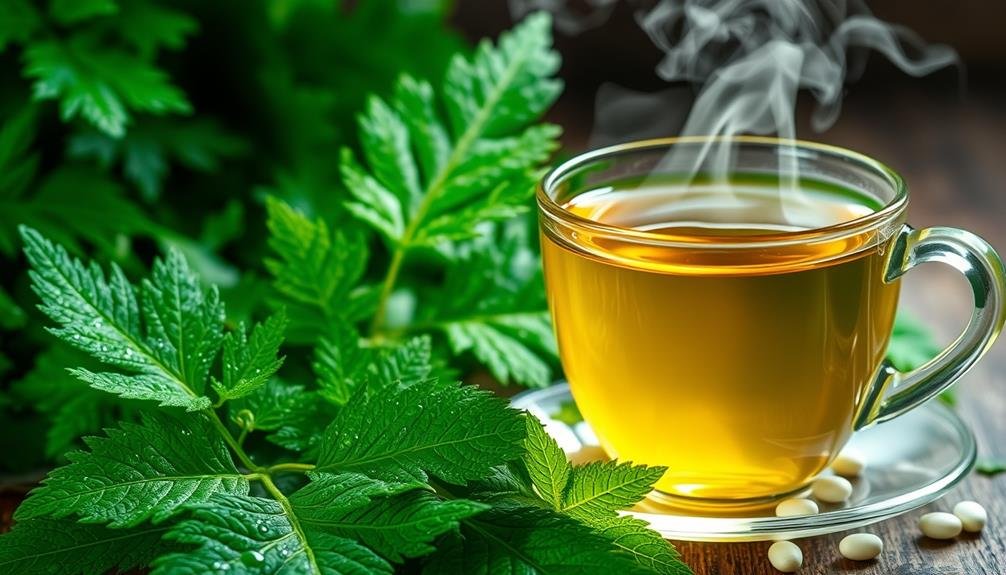
Frequently overlooked, nettle's allergy-fighting properties stem from its unique blend of compounds. These include histamine, which may seem counterintuitive, but can actually desensitize your body to allergens over time.
Nettle also contains quercetin, a natural antihistamine that helps reduce inflammation and allergy symptoms. You'll find that nettle's ability to block histamine receptors can provide relief from sneezing, itching, and congestion. It's particularly effective against seasonal allergies like hay fever.
The plant's anti-inflammatory properties also help soothe irritated nasal passages and reduce swelling in your sinuses. Nettle tea works by inhibiting several key inflammatory events that cause allergic reactions.
It can decrease the amount of histamine your body produces in response to allergens. Additionally, nettle contains compounds that may help modulate your immune system's response to allergens, potentially reducing the severity of your symptoms.
When you drink nettle tea regularly, you're not just treating symptoms but potentially addressing the root cause of your allergies. It's a natural approach that can complement or, in some cases, replace conventional allergy medications.
Harvesting Nettles Safely
When you're ready to harvest nettles, don't forget your essential protective gear.
You'll need thick gloves, long sleeves, and pants to shield your skin from the plant's stinging hairs.
To collect nettles safely, use sharp scissors or pruning shears to cut the stems cleanly, avoiding crushing or damaging the leaves.
Protective Gear Essentials
Before venturing out to harvest nettles, you'll need to gear up with essential protective equipment. Nettles are known for their stinging hairs, which can cause skin irritation and discomfort. To avoid these unpleasant encounters, make sure you're properly protected from head to toe.
Start with thick, sturdy gloves that cover your hands and wrists. Opt for leather or rubber gloves that can withstand the nettle's sharp hairs. Don't forget to wear long sleeves and pants made of durable fabric like denim or canvas. Tuck your pants into your socks or boots to prevent any exposed skin.
Here's a quick checklist of protective gear you'll need:
- Thick gloves (leather or rubber)
- Long-sleeved shirt and long pants
- Closed-toe shoes or boots
- Safety goggles or glasses
Consider wearing safety goggles or glasses to protect your eyes from any airborne particles or accidental contact with the plant.
With these protective measures in place, you'll be ready to safely harvest nettles for your allergy-relieving tea. Remember, it's always better to be over-prepared when dealing with stinging nettles.
Proper Cutting Techniques
Armed with your protective gear, it's time to master the art of nettle harvesting. Focus on cutting the top 4-6 inches of the plant, where the leaves are youngest and most tender. Use sharp pruning shears or scissors to make clean cuts, reducing plant damage and guaranteeing faster regrowth.
When harvesting, follow these guidelines:
| Do | Don't |
|---|---|
| Cut at a 45-degree angle | Pull or yank the plant |
| Harvest before flowering | Take more than 1/3 of the plant |
| Leave some plants for pollinators | Cut stems close to the ground |
| Rotate harvesting areas | Overharvest a single location |
Remember to cut nettles in the morning when they're most hydrated. This guarantees better flavor and nutrient retention. As you harvest, place the cuttings in a clean, breathable bag or basket. Avoid crushing the leaves, as this can lead to nutrient loss and make them harder to clean later.
Drying Nettles for Tea
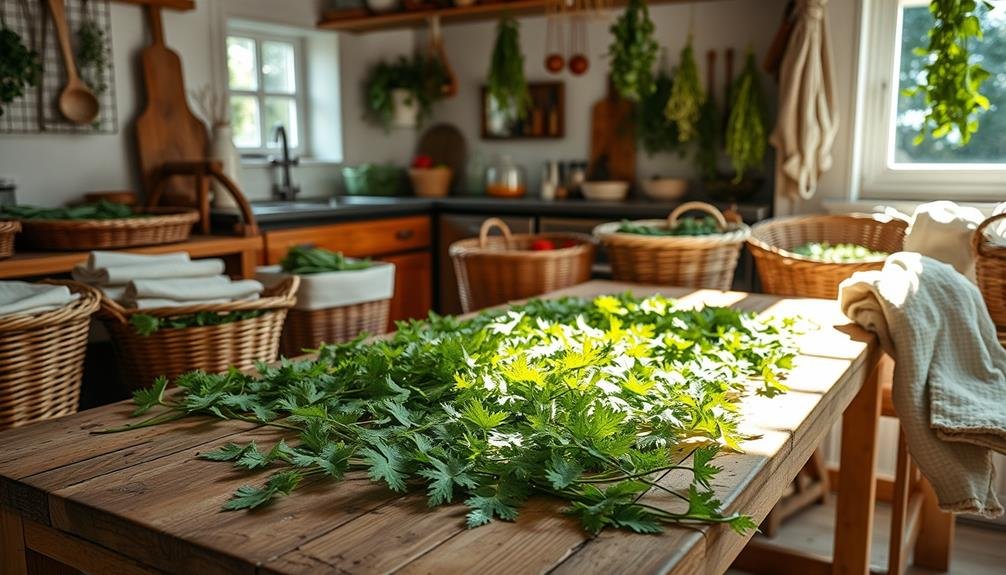
After you've harvested fresh nettle leaves, you'll need to dry them properly for tea.
You can use the air-drying technique by hanging bundles of nettles in a warm, dry place for several days.
If you're short on time, try the oven-drying method, spreading the leaves on a baking sheet and drying them at the lowest temperature setting for a few hours.
Harvest Fresh Nettle Leaves
Wondering how to gather fresh nettle leaves for your allergy-fighting tea? It's easier than you might think, but you'll need to take some precautions.
Nettles are known for their stinging hairs, so always wear thick gloves and long sleeves when harvesting.
Spring is the best time to collect young nettle leaves, as they're most tender and flavorful. Look for nettles in moist, shady areas like woodlands or near streams. Choose plants that are about knee-high and haven't flowered yet.
Here's a quick guide to harvesting:
- Pinch off the top 2-4 inches of the plant, including the first two pairs of leaves
- Collect leaves from multiple plants to avoid over-harvesting
- Rinse the leaves in cold water to remove any dirt or insects
- Use fresh leaves immediately or store them in the refrigerator for up to three days
Air-Drying Nettle Technique
If you're not planning to use your fresh nettle leaves right away, air-drying is an excellent method to preserve them for future use in tea.
Begin by gently rinsing the leaves to remove any dirt or insects. Shake off excess water and pat them dry with a clean towel. Gather the nettles into small bundles, tying them together at the stems with string or twine.
Hang these bundles upside down in a warm, dry, and well-ventilated area away from direct sunlight. A pantry, attic, or unused closet often works well. Make sure there's enough space between bundles for air to circulate freely. You can also use a drying rack or screen if you prefer not to hang them.
The drying process typically takes 1-2 weeks, depending on humidity levels and air circulation. Check your nettles regularly; they're ready when they're crisp and crumbly to the touch.
Once dried, carefully remove the leaves from the stems and store them in an airtight container. Keep the container in a cool, dark place to maintain the leaves' potency. Properly dried and stored nettle leaves can retain their beneficial properties for up to a year.
Oven-Drying Nettle Method
For those seeking a quicker drying method, oven-drying nettles can be an effective alternative to air-drying. This technique allows you to prepare your nettle leaves for tea in just a few hours.
To oven-dry nettles, you'll need a baking sheet, parchment paper, and an oven with a low-temperature setting.
Start by preheating your oven to its lowest setting, ideally between 120°F and 150°F. Wash the nettle leaves thoroughly and pat them dry with a clean towel. Spread the leaves in a single layer on a parchment-lined baking sheet, ensuring they don't overlap.
Place the sheet in the oven and leave the door slightly ajar to allow moisture to escape.
Check the nettles every 30 minutes, rotating the baking sheet for even drying. The process typically takes 2-4 hours, depending on your oven and the leaves' moisture content. You'll know they're ready when they're crisp and crumble easily.
Follow these steps for best results:
- Preheat oven to lowest setting (120°F-150°F)
- Arrange clean, dry leaves on parchment-lined sheet
- Dry for 2-4 hours, checking every 30 minutes
- Remove when leaves are crisp and crumbly
Optimal Brewing Techniques
To get the most out of your nettle tea for allergy relief, proper brewing techniques are essential. Start by using 1-2 teaspoons of dried nettle leaves per cup of water. If you're using fresh leaves, double the amount. Boil water and pour it over the leaves in a teapot or infuser. Let the tea steep for 10-15 minutes to extract the maximum benefits.
For a stronger brew, you can increase the steeping time up to 30 minutes. However, be aware that longer steeping may result in a more bitter taste. If you find the flavor too intense, add a touch of honey or lemon to improve palatability.
To preserve the tea's medicinal properties, don't add milk, as it can interfere with the absorption of certain compounds. Drink the tea while it's still warm for best effects. You can consume up to 3 cups daily for allergy relief.
If you're planning to drink it cold, brew a stronger concentration and dilute it with ice or cold water. Remember to store any leftover tea in the refrigerator and consume it within 24 hours for the best results.
Dosage and Frequency Recommendations
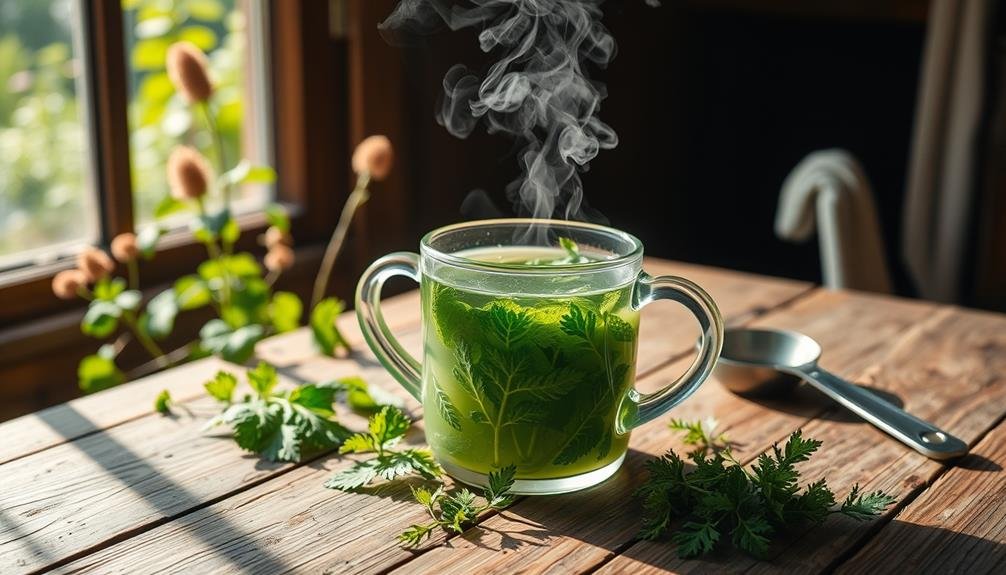
When it comes to dosage and frequency, it's important to strike the right balance for ideal allergy relief. Generally, you'll want to consume 1-3 cups of nettle tea daily during allergy season. Start with one cup and gradually increase if needed.
It's best to drink your tea about 30 minutes before meals for best absorption.
For maximum effectiveness, consider these recommendations:
- Begin drinking nettle tea 2-3 weeks before allergy season starts to build up your body's defenses.
- Consume your tea consistently throughout the day, rather than all at once.
- If you're using dried nettle leaves, steep 1-2 teaspoons per cup of hot water.
- For those using tea bags, use one bag per cup and steep for 5-10 minutes.
Combining Nettle With Other Herbs
Combining nettle with other herbs can enhance its allergy-fighting properties and provide additional health benefits. Consider pairing nettle with peppermint to soothe sinus congestion and improve overall respiratory function. The menthol in peppermint complements nettle's anti-inflammatory effects, offering a powerful one-two punch against allergy symptoms.
For those struggling with seasonal allergies, adding elderberry to your nettle tea can boost your immune system and reduce the severity of allergic reactions. Elderberry's antiviral properties work alongside nettle's antihistamine effects to provide extensive allergy relief.
If you're looking to address multiple allergy-related issues, try blending nettle with chamomile and licorice root. This combination can help calm an upset stomach, reduce inflammation, and promote relaxation. The soothing properties of chamomile and the natural sweetness of licorice root make this blend both effective and enjoyable.
For a detoxifying blend, mix nettle with dandelion root. This combination supports liver function and helps eliminate toxins that may exacerbate allergy symptoms. The diuretic properties of both herbs can also help reduce fluid retention and bloating associated with allergies.
Potential Side Effects
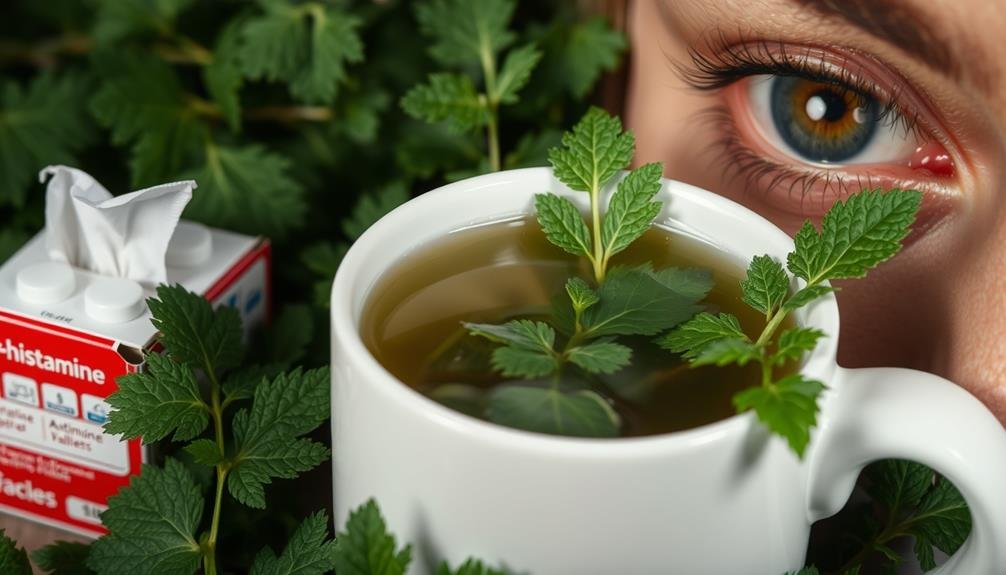
While nettle tea is generally safe for most people, potential side effects shouldn't be overlooked. When consuming nettle tea, you might experience mild digestive issues, such as stomach upset or diarrhea, especially if you're new to the herb or drink large quantities.
Some people may also develop allergic reactions, including skin rashes or itching.
If you're pregnant or breastfeeding, consult your healthcare provider before drinking nettle tea, as its effects on fetal development and lactation aren't fully understood. Nettle can also interact with certain medications, particularly blood thinners, diabetes drugs, and diuretics.
To minimize the risk of side effects, consider these precautions:
- Start with small amounts and gradually increase your intake
- Don't consume nettle tea if you have a known allergy to plants in the Urticaceae family
- Avoid nettle tea if you're taking medications that interact with it
- Stop drinking nettle tea and seek medical advice if you experience any unusual symptoms
Nettle Tea vs. Antihistamines
When considering nettle tea as an alternative to antihistamines for allergy relief, you'll want to compare their effectiveness and side effects.
While antihistamines often provide quick relief, nettle tea may offer a more gradual but sustained effect with fewer drowsiness-related side effects.
You'll need to weigh the potential benefits of nettle tea's natural approach against the proven track record of pharmaceutical antihistamines in managing allergy symptoms.
Effectiveness Comparison
The effectiveness battle between nettle tea and antihistamines has been a topic of interest for allergy sufferers seeking relief. While both options can provide allergy symptom relief, they differ in their approach and overall impact on your body.
Antihistamines work by blocking histamine receptors, providing quick relief from allergy symptoms. They're widely available and backed by extensive clinical research. However, they can cause drowsiness and other side effects, potentially affecting your daily activities.
Nettle tea, on the other hand, offers a natural approach to allergy relief. It's believed to work by reducing inflammation and modulating the immune response. While scientific studies on nettle tea's effectiveness are limited compared to antihistamines, many users report positive results without significant side effects.
To help you decide which option might work best for you, consider these factors:
- Speed of relief
- Potential side effects
- Long-term health impact
- Personal preference for natural vs. synthetic solutions
Ultimately, the effectiveness of nettle tea versus antihistamines can vary from person to person. You might find that a combination of both works best for managing your allergy symptoms throughout the season.
Side Effects Differences
Understanding the side effects of nettle tea and antihistamines can help you make an informed decision about your allergy treatment. While both options can provide relief, their side effect profiles differ considerably.
Nettle tea is generally well-tolerated, with few reported side effects. You might experience mild stomach upset or a slight tingling sensation when drinking it. In contrast, antihistamines can cause various side effects, ranging from drowsiness to dry mouth and blurred vision.
Here's a comparison of potential side effects:
| Side Effect | Nettle Tea | Antihistamines |
|---|---|---|
| Drowsiness | Rare | Common |
| Dry Mouth | Uncommon | Common |
| Stomach Issues | Mild | Possible |
It's important to note that nettle tea may interact with certain medications, such as blood thinners and diabetes drugs. Always consult your doctor before adding nettle tea to your routine, especially if you're pregnant, nursing, or taking other medications. Antihistamines can also interact with various drugs and may not be suitable for everyone. Your healthcare provider can help you weigh the pros and cons of each option based on your individual health needs and medical history.
Seasonal Timing for Best Results
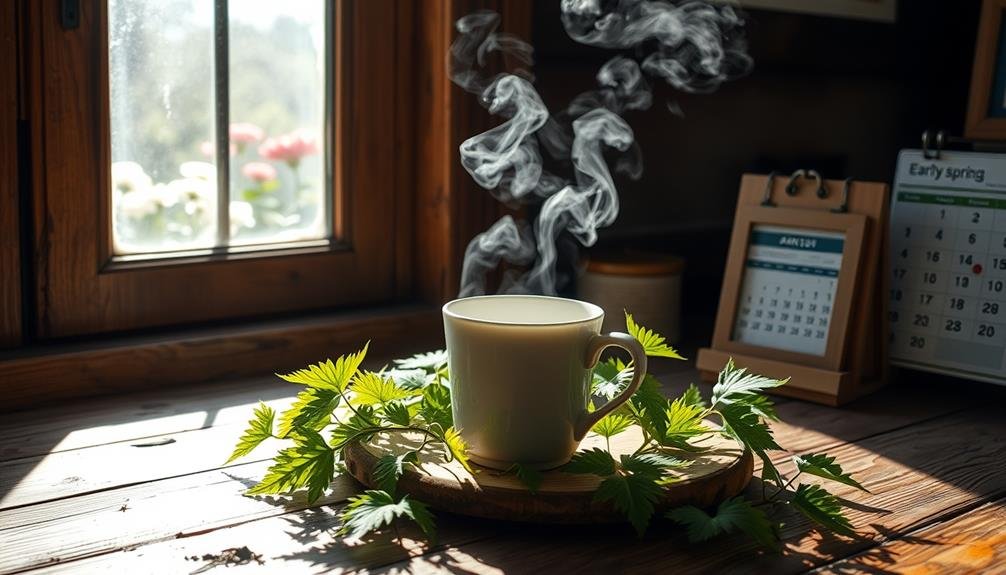
For ideal results, timing your nettle tea consumption with the allergy season is essential. Begin drinking nettle tea about two weeks before your typical allergy symptoms start. This proactive approach allows the tea's natural antihistamine properties to build up in your system, potentially reducing the severity of your symptoms when pollen counts rise.
During peak allergy season, you'll want to maintain a consistent nettle tea routine. Aim for 1-3 cups daily, adjusting based on your symptoms and tolerance. As the season winds down, you can gradually reduce your intake, but don't stop abruptly.
To maximize nettle tea's effectiveness throughout allergy season:
- Track local pollen forecasts to anticipate high-risk days
- Increase your intake on days with higher pollen counts
- Combine nettle tea with other natural remedies for enhanced relief
- Stay hydrated with water alongside your nettle tea consumption
Storing Nettle Tea Properly
Proper storage of nettle tea is key to maintaining its potency and effectiveness throughout allergy season. To guarantee your nettle tea retains its beneficial properties, you'll want to store it correctly, whether it's in dried, fresh, or brewed form.
For dried nettle leaves, keep them in an airtight container away from light, heat, and moisture. Store them in a cool, dark place like a pantry or cupboard. If you've purchased pre-packaged tea bags, follow the manufacturer's instructions, but generally, they'll also benefit from similar storage conditions.
Here's a quick guide for storing different forms of nettle tea:
| Form | Storage Method | Shelf Life |
|---|---|---|
| Dried leaves | Airtight container | 1-2 years |
| Fresh leaves | Refrigerator | 3-5 days |
| Brewed tea | Refrigerator | 3-4 days |
When storing brewed nettle tea, allow it to cool completely before transferring it to an airtight container in the refrigerator. Don't leave it at room temperature for more than 2 hours to prevent bacterial growth. By following these storage guidelines, you'll guarantee your nettle tea remains fresh and effective for allergy relief throughout the season.
Enhancing Flavor Naturally
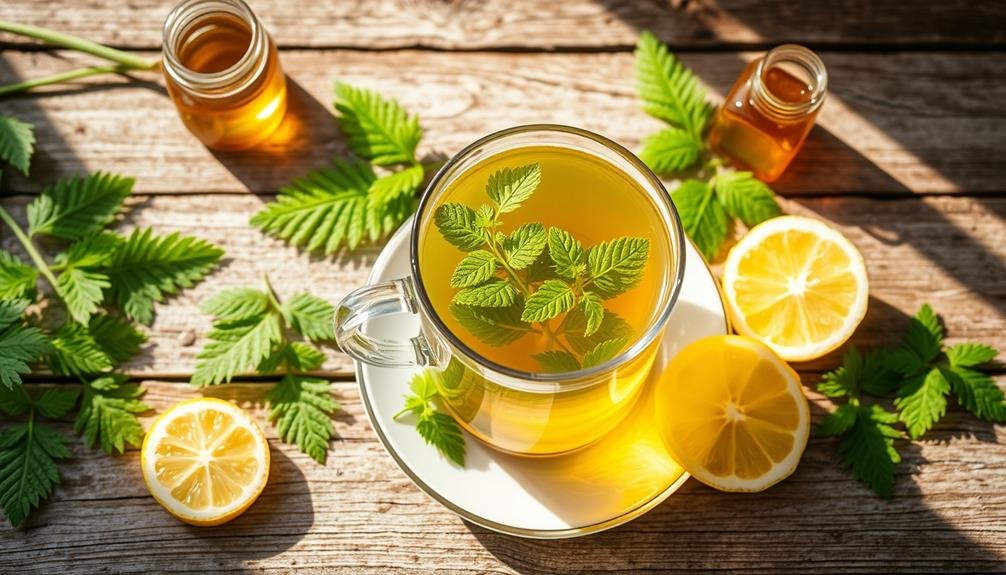
While nettle tea offers numerous health benefits, its earthy flavor can be an acquired taste for some. If you're looking to enhance the flavor naturally, there are several options you can try. Adding a touch of honey or agave nectar can provide sweetness without overpowering the tea's natural taste.
For a citrusy twist, squeeze in some fresh lemon juice, which also boosts vitamin C content. You can also experiment with complementary herbs like mint, chamomile, or ginger to create unique flavor combinations.
To further elevate your nettle tea experience, consider these creative ideas:
- Steep nettle tea with a cinnamon stick for a warm, spicy note
- Add a few drops of vanilla extract for a subtle, aromatic sweetness
- Blend in a small amount of coconut milk for a creamy, tropical flavor
- Infuse your tea with fresh berries like strawberries or raspberries
Long-Term Benefits of Regular Consumption
Beyond its immediate allergy-relieving effects, regular consumption of nettle tea can offer a range of long-term health benefits. By incorporating this herbal brew into your daily routine, you'll be supporting your overall health and well-being.
Nettle tea's anti-inflammatory properties can help reduce chronic inflammation throughout your body, potentially lowering your risk of heart disease, diabetes, and certain cancers. It's also rich in antioxidants, which combat free radicals and may slow the aging process.
You'll notice improved urinary health, as nettle tea acts as a natural diuretic, flushing out toxins and supporting kidney function. It can also help maintain healthy blood sugar levels, making it beneficial for those with or at risk of diabetes.
Regular consumption may boost your immune system, helping you ward off colds and flu more effectively. Nettle tea's high mineral content, including iron and calcium, supports bone health and can help prevent anemia.
For men, nettle tea may promote prostate health and alleviate symptoms of benign prostatic hyperplasia.
Women may experience relief from menstrual cramps and hormonal imbalances.
Growing Your Own Nettle Plants
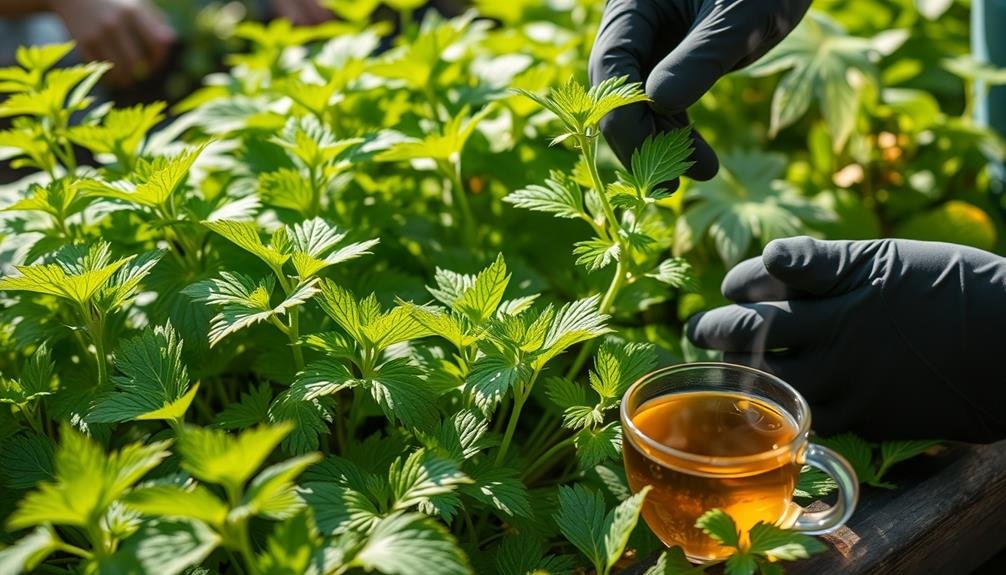
Growing your own nettle plants offers three key advantages: a sustainable supply of fresh nettles for tea, control over growing conditions, and cost-effectiveness.
You'll enjoy a continuous harvest of this beneficial herb right in your backyard.
To start your nettle garden, choose a partially shaded area with rich, moist soil. Nettles thrive in these conditions and can grow up to 4 feet tall.
Plant seeds or seedlings in early spring, spacing them about 12 inches apart. Water regularly and add organic compost to nourish the plants.
Harvest your nettles when they're young, about 6-8 inches tall, for the best flavor and medicinal properties. Wear gloves to protect yourself from the stinging hairs.
Cut the stems about 2 inches above the ground to encourage regrowth.
Here's a quick guide to maintaining your nettle garden:
- Mulch around plants to retain moisture
- Prune regularly to prevent overgrowth
- Divide established plants every 3-4 years
- Collect seeds in late summer for future planting
With proper care, you'll have a thriving nettle patch that provides a steady supply of fresh leaves for your allergy-fighting tea all season long.
Frequently Asked Questions
Can Pregnant Women Safely Drink Nettle Tea for Allergy Relief?
You should consult your doctor before drinking nettle tea while pregnant. It's generally considered safe in moderation, but it can affect hormone levels and may stimulate contractions. Your healthcare provider can offer personalized advice for your situation.
Is Nettle Tea Effective for Pet Allergies in Humans?
You may find nettle tea helpful for pet allergies. It's known to reduce histamine reactions and inflammation. While it can't cure allergies, it might ease symptoms. Always consult your doctor before trying new remedies.
How Does Nettle Tea Compare to Other Natural Allergy Remedies?
You'll find nettle tea compares favorably to other natural allergy remedies. It's as effective as butterbur and quercetin, but with fewer side effects. It's also more readily available and easier to prepare than some alternatives.
Can Children Drink Nettle Tea for Allergy Relief?
You can give children nettle tea for allergies, but consult a pediatrician first. It's generally safe in small amounts, but you'll want to monitor their reaction. Start with a weak brew and adjust as needed.
Does Nettle Tea Help With Food Allergies or Only Environmental Allergies?
Nettle tea primarily helps with environmental allergies, but it's not proven effective for food allergies. You'll find it most useful for pollen, dust, and pet dander reactions. It won't cure your food sensitivities, so don't rely on it.
In Summary
You've now got the knowledge to brew your own nettle tea for natural allergy relief. Remember to harvest safely, dry properly, and brew efficiently for the best results. Don't forget to store your tea correctly and experiment with natural flavor enhancers. By growing your own nettles, you'll have a sustainable supply. With regular consumption, you're likely to experience long-term benefits beyond allergy relief. Embrace this natural remedy and breathe easier!

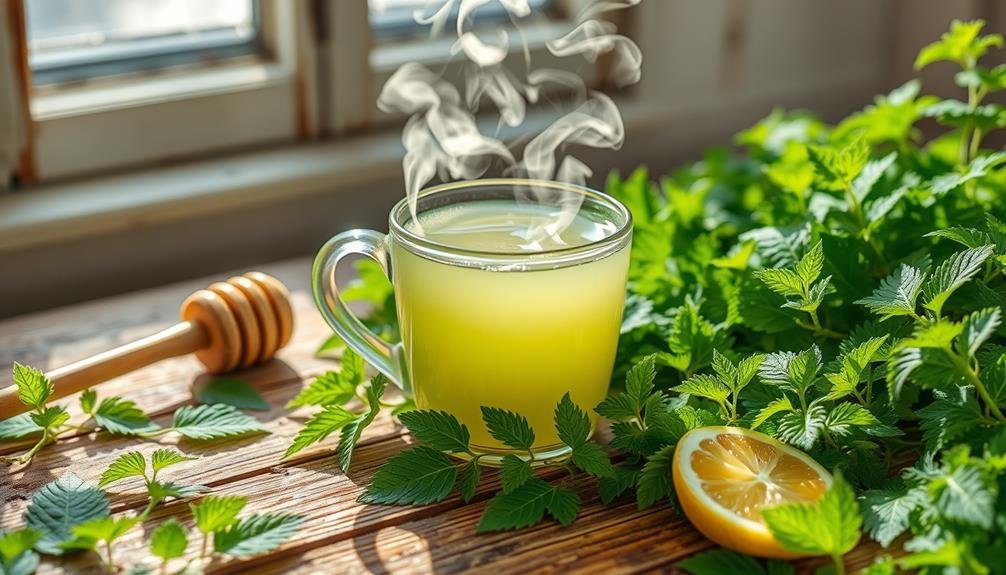
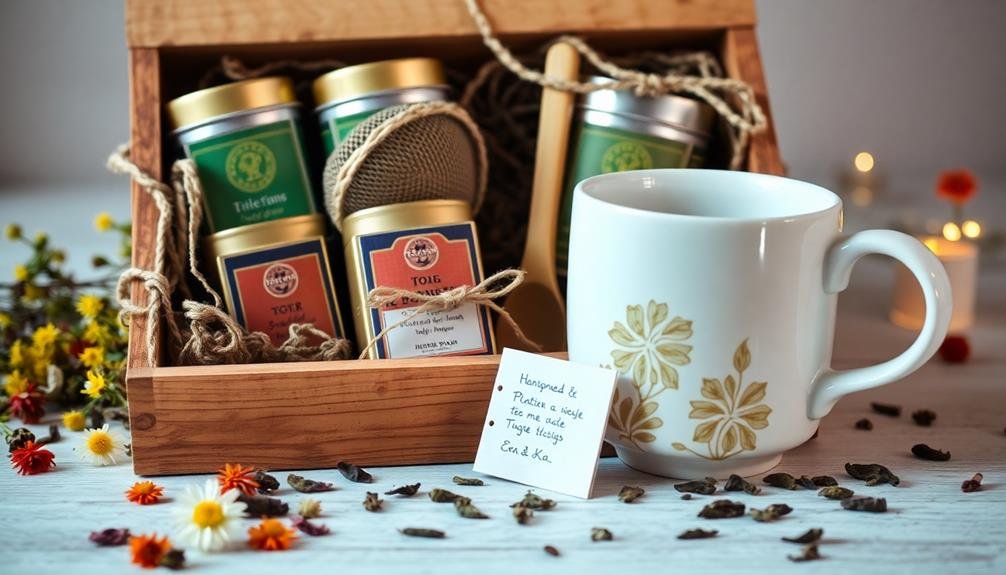
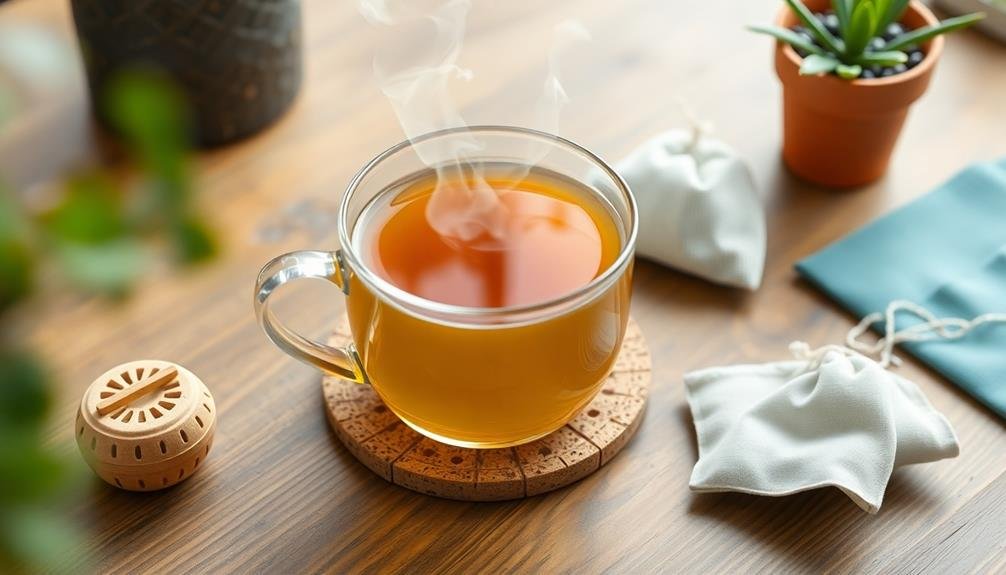

Leave a Reply